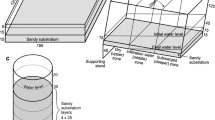Abstract
Investigations into zonation of estuarine invertebrates often indicate that animals living higher in the intertidal region have greater tolerance to effects of aerial exposure. Desiccation tolerances ofEurypanopeus depressus, a xanthid mud crab, were measured in the laboratory for both intertidal and subtidal populations to determine whether intertidal distribution is the result of either increased physiological resistance to drying or other factors. Initially, both populations had a similar percentage of body weight due to water, and at time of death both had lost a similar percentage of water. Desiccation tolerance increased exponentially with size. In laboratory experiments,E. depressus appears very susceptible to desiccation stress with loss of tactile response occurring at 30% depletion of body water. This crab may be able to avoid desiccation and survive in the intertidal zone by remaining in the shelter and moisture of oyster shells and mud at low tide. However,E. depressus may not be limited strictly by physical factors of its environment. Biotic factors such as behavior leading to predator avoidance are possibly more important components in limiting distribution.
Similar content being viewed by others
Literature Cited
Barr, A. J., J. H. Goodnight, J. P. Sall, andJ. T. Helwig. 1977. A user's guide to SAS 76. SAS Institute Inc., Raleigh, N. C. 329 p.
Connell, J. H. 1961. The influence of interspecific competition and other factors on the distribution of the barnacleChthamalus stellatus Ecology 42:710–723.
Davies, P. S. 1969. Physiological ecology ofPatella. III. Desiccation effects.J. Mar. Biol. Ass. U.K. 49:291–304.
Dayton, P. K. 1971. Competition, disturbance, and community organization: the provision and subsequent utilization of space in a rocky intertidal community.Ecol. Monogr. 41:351–389.
Foster, B. A. 1971. Desiccation as a factor in the intertidal zonation of barnacles.Mar. Biol. 8:12–29.
Fraenkel, G. 1968. The heat resistance of intertidal snails at Bimini, Bahamas; Ocean Springs, Miss.; and Woods Hole, Mass.Physiol. Zool. 41:1–13.
Hardin, D. D. 1968. A comparative study of lethal temperatures in the limpets.Acmaea scabra andAcmaea digitalis.Veliger 11 (Suppl.):83–87.
Herreid, C. F. 1969. Water loss of crabs from different habitats.Comp. Biochem. Physiol. 28:829–839.
Hollander, M., andD. A. Wolfe. 1973. Nonparametric statistical methods. John Wiley and Sons, New York. 503 p.
Kennedy, V. S. 1976. Desiccation, higher temperatures, and upper intertidal limits of three species of sea mussels (Mollusca: Bivalvia) in New Zealand.Mar. Biol. 35:127–137.
Kensler, C. B. 1967. Desiccation resistance of intertidal crevice species as a factor in their zonation.J. Anim. Ecol. 36:391–406.
Lunz, G. R., Jr. 1937. Xanthidae (mud crabs) of the Carolinas.Charleston Museum Leaflet 9:9–28.
McDermott, J. J. 1960. The predation of oysters and barnacles by crabs of the family Xanthidae,Proc. Penn. Acad. Sci. 34:199–211.
McDonald, H. J. 1977. The comparative intertidal ecology and niche relations of the sympatric mud crabsPanopeus herbstii Milne-Edwards andEurypanopeus depressus (Smith) at North Inlet, South Carolina, USA (Decapoda: Brachyura: Xanthidae). Ph.D. Dissertation, University of South Carolina. 233 p.
Paine, R. T. 1966. Food web complexity and species diversity.Amer. Natur. 100:65–75.
Ryan, E. P. 1956. Observations on the life histories and the distribution of the Xanthidae (mud crabs) of Chesapeake Bay.Amer. Midl. Natur. 56:138–162.
Sanders, H. L. 1968. Marine benthic diversity: a comparative study.Amer. Natur. 102:243–282.
Sanders, H. L. 1969. Benthic marine diversity and the stability-time hypothesis.In Diversity and Stability in Ecological Systems.Brookhaven Symposium Biol. 22:71–81.
Sandison, E. E. 1966. The oxygen consumption of some intertidal gastropods in relation to zonation.J. Zool. 149:163–173.
Segal, E., andP. A. Dehnel 1962. Osmotic behavior in an intertidal limpet,Acmaea limulata.Biol. Bull. 122: 417–430.
Vader, W. J. M. 1964. A preliminary investigation into the reactions of the infauna of the tidal flats to tidal fluctuations in water level.Neth. J. Sea Res. 2:189–222.
Wolcott, T. G. 1973. Physiological ecology and intertidal zonation in limpets (Acmaea): A critical look at “limiting factors”.Biol. Bull. 145:389–422.
Young, A. M. 1978. Desiccation tolerances for three hermit crab speciesClibanarius vittatus (Bosc),Pagurus pollicaris Say andP. longicarpus Say (Decapoda, Anomura) in the North Inlet Estuary, South Carolina, U.S.A.Estuar. Coast. Mar. Sci. 6:117–122.
Author information
Authors and Affiliations
Rights and permissions
About this article
Cite this article
Grant, J., McDonald, J. Desiccation tolerance ofEurypanopeus depressus (smith) (Decapoda: Xanthidae) and the exploitation of microhabitat. Estuaries 2, 172–177 (1979). https://doi.org/10.2307/1351731
Issue Date:
DOI: https://doi.org/10.2307/1351731




